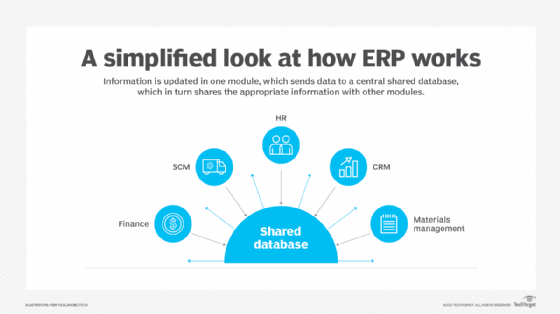What are the challenges and benefits of ERP software?
The pros and cons have been fairly consistent over the years, but the move from on premises to cloud changes the equation in cost, customization and deployment speed.
The advantages and disadvantages of implementing ERP software are well documented. Nevertheless, the nature of ERP systems is changing as enterprises shift from on premises to cloud computing, and as data from nearly every aspect of life -- from home fitness to grocery shopping to car travel -- is collected, stored, analyzed and acted upon. Consequently, the human and economic investments required to support these shifts are changing, too. So, it's worth reexamining the pros and cons of ERP.
What are the advantages of implementing ERP?
Reality check. When enterprises consider ERP systems, it forces a reckoning in several ways. First, they must account for the hardware and software systems that are already in place. Many of them discover that different business and support units throughout the organization might have circumvented central IT protocol and acquired their own applications and systems. Purchases made in such a disorganized fashion, known as shadow IT, result in inefficiency and lack of interoperability.
Once enterprises see the weaknesses and redundancies in their software strategy, they can plot a course to set things right. The best aspect of this reality check is that it affords enterprises the opportunity to better link IT and business units. Some will go so far as to embed full-time IT workers in the business units so that they better understand how that unit functions and where the inefficiencies are.
Lower IT costs. To be clear, the savings don't come immediately. A new ERP system is a major investment and implementing one is always time-consuming. However, one unified ERP system costs less than disparate systems for human resources, financial management and supply chain management. Ultimately, you might save on software licenses, training and support. But your mileage might vary.
End-to-end visibility. One of the sexiest features of ERP is that it allows high-level decision makers real-time snapshots of business operations. This includes an integrated view of areas such as inventory, shipping, supply chain management, manufacturing, sales and financials. All this data provides actionable business intelligence (BI). For example, if daily inventory levels are showing a pattern, then the supply chain can be adjusted so the right levels of the right products are in the right place and at the right time. The availability of this data on a single dashboard can also encourage collaboration and give great insight into workflow efficiencies and employee productivity.
Planning and reporting. Improved visibility means that accurate reports, reflecting activity across the enterprise, can be generated quickly. Because different business units can see the same data, managers are literally on the same page. That reduces communication errors caused by duplicate spreadsheets and emails, as well as pointless finger-pointing. Reporting tools, particularly those for financial reporting, are typically baked into ERP software. Many ERP systems also offer BI applications that let organizations take a deeper dive into their data.
Because of their BI and automated reporting capabilities, ERP systems are also a boon to corporate compliance. Many financial ERP systems have specific compliance features built in to address regulations such as the General Data Protection Regulation (GDPR), the Health Insurance Portability and Accountability Act (HIPAA), the Payment Card Industry Data Security Standard (PCI DSS), Sarbanes-Oxley (SOX), and the draft Secure Software Development Framework (SSDF) put forth by the National Institute of Standards and Technology (NIST).
Data security. Data security can be a blessing or a curse. While having a central repository for your data can be nerve-wracking, ERP systems and service providers that host them often have better data security in place than enterprises that host their own on-premises ERP systems.

What are the challenges of implementing ERP?
Data security. When it comes to data security, ERP can be a blessing or a curse. On one hand, all your data is in one place where you can keep an eye on it. On the other hand, all your data is in one place where cybercriminals can look. If your ERP system is hosted in the cloud by a third party, which most of them are, you might not have complete control over your sensitive data. At the very least, the company hosting the software has access to your data.
Another challenge is that many ERP systems are secured only by username and password. Such credentials are often the target of phishing attacks. So, to make ERP systems secure, added security, such as multifactor authentication or data masking, must be considered.
Total cost. While ERP systems can result in lower per-capita IT costs, particularly for things like training, the upfront costs are almost always higher. The software itself will cost well into the five figures at a minimum. The cost of implementation -- when you factor in ERP consultants for project management and new IT hires -- can be more than three times that of standard, stand-alone applications. The cost of maintenance -- either offered as automated updates by vendors (for a fee) or performed by in-house staff -- is another chunk of change. On-premises ERP software vendors might charge annual maintenance fees of 15% to 25%, including security patches.
In contrast, the upfront costs of cloud options, especially SaaS ERP, are a fraction of what on-premises ERP costs, since the software is usually purchased through a monthly subscription fee that also typically includes maintenance. However, numerous studies show SaaS can exceed the cost of on-premises ERP after seven to 10 years.
Customization. This can be costly. Most enterprises only consider ERP software in the first place because the applications are modular, allowing users to pick and choose which ones they want, knowing that they can be snapped together. However, one size seldom fits all, and some customization is often needed. If you host your ERP system on-premises, you have more opportunities to customize it, but dedicating the IT manpower to it can be challenging. Organizations that own on-premises ERP software will sometimes use PaaS to facilitate customization.
Data migration. It's the single biggest challenge for most enterprises. Whether your data is paper-based or in digital form, it will take time and money to move it, clean it up to remove obsolete or duplicate items, and conform it to the new format. Data security during and after the migration process carries great risk.
Another challenge to data migration for larger enterprises is deciding what portions of the data should be moved over and when. Increasingly, migrating a big, monolithic ERP all at once is falling out of favor, and organizations are instead picking off pieces to move.
Today, given the strong trend away from on-premises ERP toward cloud, implementing cloud ERP is the right course for most large organizations. Special consideration must be given, however, to the inherent challenges of data migration, data security and total cost of ownership, including maintenance.
Kevin Ferguson has written about technology for many years and many publications. He is a regular contributor to TechTarget. He has also produced radio and film for NPR and PBS. Kevin holds a B.A. in journalism from Rutgers University and an MPA from Harvard University.







